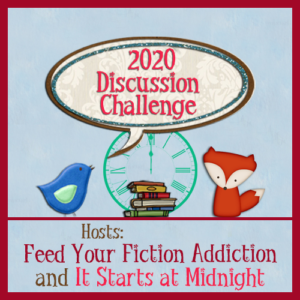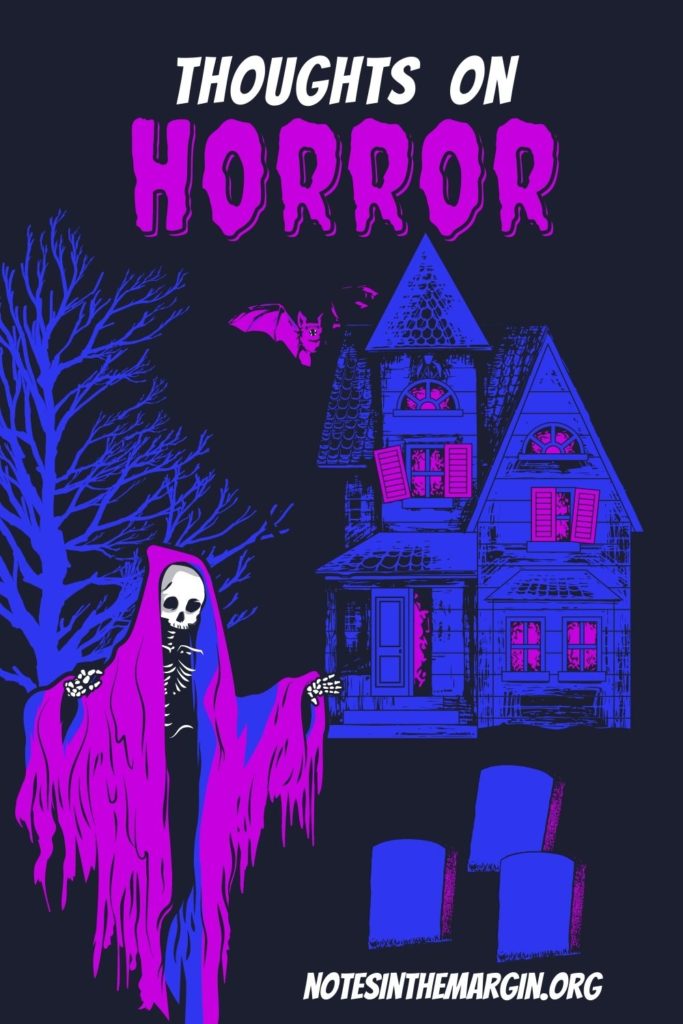
Thanks to these two bloggers for sponsoring the 2020 Blog Discussion Challenge:
- Nicole at Feed Your Fiction Addiction
- Shannon at It Starts at Midnight
You can join the discussion challenge at any time during 2020 by clicking on either link above.
Introduction
Ever since I started Notes in the Margin back in the late 1990s, I’ve been saying that I don’t like, and therefore don’t read, horror literature, particularly books about vampires, werewolves, and zombies. However, lately I’ve read several articles about horror that have convinced me it might be time for me to re-examine my position on reading it. After all, the whole world is currently experiencing a particular kind of horror.
This summer, as the world was thrown into uncertainty by a pandemic and our collective sense of normalcy was lost, readers flocked to horror novels, propelling tales of terror onto bestseller lists in a way the genre hasn’t seen in decades.
—Michael J. Seidlinger
I understand that vampires, werewolves, and zombies can function as metaphors for the state of human existence. I just don’t like reading about them. I can’t really explain why, just as I can’t explain why I don’t like liver. I just don’t.
But I do like a good ghost story.
I recently read and enjoyed The Sun Down Motel by Simone St. James. In her discussion of the difference between thrillers and horror, Anna Gooding-Call says that this novel is horror rather than a thriller because it involves actual ghosts. And that makes me wonder if there are other kinds of horror literature that I might like as well.
What Is Horror Literature?
To start at the beginning: What is horror literature?
The New York Public Library Literature Companion defines it this way:
Horror story: “A story designed to frighten its readers. Fear may be evoked through some combination of supernatural and fantastic elements, the suggestion of violence, the macabre, and psychological torments, the latter particularly important as many writers have exploited the dark and profoundly terrifying reaches of the reader’s own mind. Its roots are intertwined with those of the Gothic novel; the two genres emerged in the 18th century as a form of amusement that thrilled through terror” (p. 650).
The website Literary Terms offers a similar definition:
In literature, horror . . . is a genre of fiction whose purpose is to create feelings of fear, dread, repulsion, and terror in the audience—in other words, it develops an atmosphere of horror. The term’s definition emphasizes the reaction caused by horror, stemming from the Old French orror, meaning “to shudder or to bristle.” . . . Horror feeds on audience’s deepest terrors by putting life’s most frightening and perplexing things—death, evil, supernatural powers or creatures, the afterlife, witchcraft—at the center of attention.
Most of the definitions of horror that I’ve read are descriptive: horror literature creates an overall atmosphere of feeling that can range from generalized dread to outright fear. As Anna Gooding-Call puts it, “The goal of horror is to evoke existential terror, disgust, or revulsion. If it’s eerie, it’s horror. Look for lots of supernatural goings-on and big metaphorical statements about society.”
A salient characteristic of horror literature is that it presents dualities, things that both attract and repel us. Just as people can’t resist slowing down while driving past a bad accident on the highway, we can’t look away. Horror literature produces the ambivalent feeling of both pleasure and disgust.
During my research about horror I found particularly interesting discussions about the overlap between what we commonly call literary fiction and horror literature. Christopher Shultz offers a list of 10 novels, ranging chronologically from Frankenstein, Or The Modern Prometheus (1888) by Mary Shelley to The Fever (2014) by Megan Abbott, “that effectively utilize horror elements.”
Marc E. Fitch goes so far as to say that all literature is based on horror:
Literary fiction, while often embracing a wider range of human emotion and experience [than horror], is built on a foundation of suffering, despair and the prospect of each individual’s approaching death. Death—and the forms it takes—is the ultimate human fear.
Much literary fiction, Fitch argues, “[causes] us to confront our mortality through the everyday tragedies of life.” Fiction deals in our feelings of guilt, remorse, and unfulfilled longing. “Literary fiction, in its attempt to confront reality, is built on a foundation of insanity, meaninglessness, brutality and death.”
I find Fitch’s view of literature and life overly pessimistic, but I sympathize with his notion that literature often examines human imperfections in our efforts to understand and cope with the realities of existence.
But I agree with the notion that there’s a close relationship between crime fiction and horror. I read a lot of mysteries and psychological thrillers, and many of those books, with their emphasis on fear, push right up close to the boundaries of horror fiction. I didn’t realize just how close the two genres (crime fiction and horror) can be until I read Anna Gooding-Call’s article about the differences between thrillers and works of horror.
Max Booth, III, also appreciates the close relationship between crime fiction and horror:
the great thing about these two genres is, they so often tend to blend beautifully together. When I think of crossover genres, horror and crime are perfect companions. They’re the peanut butter and jelly of genres. Sure, you can have one without the other, but . . . they blow your mind when you combine them.
Among the books Booth discusses in his article about horror-crime crossovers is Red Dragon (1981) by Thomas Harris, the novel that provides the backstory of one of recent literature’s most notorious villains, Hannibal Lector: “it’s the way Thomas Harris portrays the Red Dragon’s voice that cements this one as a perfect horror/crime crossover.” I have read Red Dragon and found it riveting, but I continue to refuse to read (or see the movie) The Silence of the Lambs because I don’t want to read about cannibalism.
One of my particular areas of interest is the intersection between literature and psychology and what literature can teach us about psychology. The Silence of the Lambs appeals to me because of its purported psychological interplay between Hannibal Lector and Clarice Starling. But despite the book’s appeal, I’m not going to read it because I don’t think I could stomach the cannibalism. (My stomach feels queasy from just writing about it.)
And here I think I’ve finally found out what I wanted to know when I began thinking about horror literature: given the relationship between thrillers/mysteries and horror, I need to understand exactly where my boundaries between them lies. Max Booth’s article has helped me begin to figure that out.
I’ve read two of the other books Booth discusses, Dark Places by Gillian Flynn and In the Woods by Tana French. He calls both dark thrillers, and I certainly agree. But neither of them bothered me the way thinking about reading The Silence of the Lambs bothers me. Booth’s description of French’s book applies here: “There is always a hint of something … deeper going on in her books. . . . We’re dipping our toes in the possibility of something cosmic happening, but we’re never actually taking the full dive.”
At the other end of the spectrum is the other book from Booth’s list that I’ve read, Sarah Pinborough’s 2017 novel Behind Her Eyes. As Booth acknowledges, you can’t say much about this novel without giving too much away, so I’ll just say that this is the novel that prompted me to think about what horror literature is and isn’t. Although I see this title on a lot of lists of horror works, I don’t classify it as horror. Thinking about this novel doesn’t make me queasy, as The Silence of the Lambs does. It just makes me angry. I know that’s cryptic, but it’s the best I can do here. If you’re curious, read the book (but don’t say I didn’t warn you).

Why Horror Appeals to Us
If horror literature makes us feel uncomfortable emotions like fear and disgust, why does it appeal to readers so much? Michael J. Seidlinger explains the appeal this way:
readers continue to turn to horror to confront reality, as well as for a good old-fashioned, albeit terrifying, escape. It helps when the escape gives readers the chance to trust in the narrative and know well that the horror on the page is far more controllable than the horror outside their front doors.
Or, as Xavier Aldana Reyes writes, “With horror novels and films, you know you’re experiencing fear in a safe space that you ultimately control.”
But Reyes also writes, “In a sense, what scares us most about horror is often ourselves, where our minds will take us, which is coloured by our experiences and tastes.” And this is the experience that all literature gives us, the opportunity to learn about ourselves by watching what fictional characters do.
In fact, Reyes’s discussion of horror arrives exactly at the heart of where literature and psychology intersect:
There’s nothing more fearful than the mind; it’s where all our fears collect. When you’re experiencing fear through the psychology of someone whose grasp on the world is already compromised by their circumstances, that makes it even more powerful. The scariest of literary horrors are, in my view, not just conceptual, but also linguistic. They activate something personal. And that’s why horror is both shareable and private.
Books to Read
Reyes’s point about horror as a personal experience reinforces my earlier suspicion that I need to examine my own limits in terms of what horror I care to read. I think I’m still not terribly interested in zombies, werewolves, or vampires, and I know I don’t want to read pure gore (splatterpunk) such as a title like The Texas Chainsaw Massacre suggests. From my research, I’ve compiled a list of five recent novels that may allow me to probe further my horror comfort zone.
The descriptions here are from Goodreads, followed by my reasons for choosing each book.
1. Lock Every Door by Riley Sager
No visitors. No nights spent away from the apartment. No disturbing the other residents, all of whom are rich or famous or both. These are the only rules for Jules Larsen’s new job as an apartment sitter at the Bartholomew, one of Manhattan’s most high-profile and mysterious buildings. Recently heartbroken and just plain broke, Jules is taken in by the splendor of her surroundings and accepts the terms, ready to leave her past life behind.
As she gets to know the residents and staff of the Bartholomew, Jules finds herself drawn to fellow apartment sitter Ingrid, who comfortingly, disturbingly reminds her of the sister she lost eight years ago. When Ingrid confides that the Bartholomew is not what it seems and the dark history hidden beneath its gleaming facade is starting to frighten her, Jules brushes it off as a harmless ghost story—until the next day, when Ingrid disappears.
Searching for the truth about Ingrid’s disappearance, Jules digs deeper into the Bartholomew’s dark past and into the secrets kept within its walls. Her discovery that Ingrid is not the first apartment sitter to go missing at the Bartholomew pits Jules against the clock as she races to unmask a killer, expose the building’s hidden past, and escape the Bartholomew before her temporary status becomes permanent.
I enjoyed Sager’s two earlier books, The Last Time I Lied and Final Girls. But I put off reading the last two (this one and Home Before Dark) because the descriptions sound as if they may feature supernatural elements.
2. Lovecraft Country by Matt Ruff
Chicago, 1954. When his father Montrose goes missing, twenty-two year old Army veteran Atticus Turner embarks on a road trip to New England to find him, accompanied by his Uncle George—publisher of The Safe Negro Travel Guide—and his childhood friend Letitia. On their journey to the manor of Mr. Braithwhite—heir to the estate that owned Atticus’s great grandmother—they encounter both mundane terrors of white America and malevolent spirits that seem straight out of the weird tales George devours.
. . .
A chimerical blend of magic, power, hope, and freedom that stretches across time, touching diverse members of one black family, Lovecraft Country is a devastating kaleidoscopic portrait of racism—the terrifying specter that continues to haunt us today.
I heard of this novel in relation to the HBO series based on it. I’m particularly interested in reading the book to see how it uses horror elements as symbols (personifications?) of racism in U.S. society.
3. Mexican Gothic by Silvia Moreno-Garcia
After receiving a frantic letter from her newlywed cousin begging for someone to save her from a mysterious doom, Noemí Taboada heads to High Place, a distant house in the Mexican countryside. She’s not sure what she will find – her cousin’s husband, a handsome Englishman, is a stranger, and Noemí knows little about the region.
. . .
Her only ally in this inhospitable abode is the family’s youngest son. Shy and gentle, he seems to want to help Noemí but might also be hiding dark knowledge of his family’s past. For there are many secrets behind the walls of High Place. The family’s once colossal wealth and faded mining empire kept them from prying eyes, but as Noemí digs deeper she unearths stories of violence and madness.
This book has gotten almost universally good reviews. But I particularly want to read it because I’ve read a couple of articles in which the author insists that the novel is gothic horror. This book most likely illustrates the relationship between horror and the gothic novel.
4. The Woman in Black by Susan Hill
Set on the obligatory English moor, on an isolated causeway, the story has as its hero Arthur Kipps, an up-and-coming young solicitor who has come north from London to attend the funeral and settle the affairs of Mrs. Alice Drablow of Eel Marsh House. The routine formalities he anticipates give way to a tumble of events and secrets more sinister and terrifying than any nightmare: the rocking chair in the deserted nursery, the eerie sound of a pony and trap, a child’s scream in the fog, and most dreadfully–and for Kipps most tragically–The Woman In Black.
The Woman In Black is both a brilliant exercise in atmosphere and controlled horror and a delicious spine-tingler–proof positive that this neglected genre, the ghost story, isn’t dead after all.
As I said at the beginning, I like a good ghost story. This book also has roots in the gothic novel genre.
5. Home Before Dark by Riley Sager
In the latest thriller from New York Times bestseller Riley Sager, a woman returns to the house made famous by her father’s bestselling horror memoir. Is the place really haunted by evil forces, as her father claimed? Or are there more earthbound—and dangerous—secrets hidden within its walls?
This is the other Riley Sager novel that I’ve hesitated to read. (See entry #1.) Here’s another potential ghost story as well as the trope of a writer as character.
Study Notes
Articles mentioned in This Post
Booth, III, Max. “20 Essential Crime and Horror Crossovers”
Fitch, Marc E. “Literature Is Built on a Foundation of Horror”
Gooding-Call, Anna. “Thriller vs. Horror: Your Guide”
The New York Public Library Literature Companion, ed. Anne Skillion (New York: The Free Press, 2001)
Reyes, Xavier Aldana. “The Scariest Books”
Seidlinger, Michael J. “Bookish Trend: Horror Returns From the Dead”
Shultz, Christopher. “Where Lit-Fic and Horror Converge: Ten Literary Chillers”
Additional Resources
Andrews, Jazlyn. “Unable to Turn Away: Exploring Inescapable Experiences of Horror”
Jones, Stephen Graham. “How Horror is the Puppet of Your Own Terror”
McCormack, J.W. “Interview with Brian Evenson” in The White Review
Temple, Emily. “10 Works of Literary Horror You Should Read”
© 2020 by Mary Daniels Brown


I read this post with a great deal of interest. My thoughts are that I enjoy literary horror, but genre horror doesn’t interest me. The other point I would make is that books that leave one grossed out, rather than frightened, aren’t really horror.